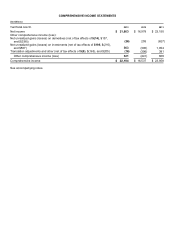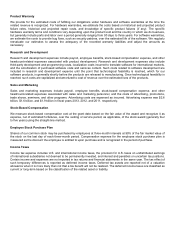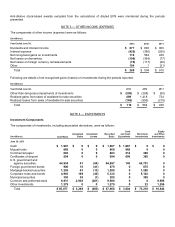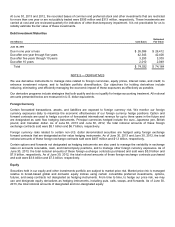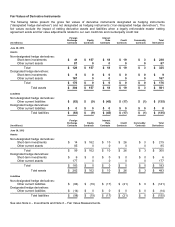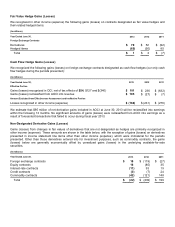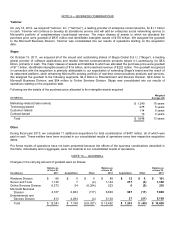Microsoft 2013 Annual Report Download - page 52
Download and view the complete annual report
Please find page 52 of the 2013 Microsoft annual report below. You can navigate through the pages in the report by either clicking on the pages listed below, or by using the keyword search tool below to find specific information within the annual report.
Allowance for Doubtful Accounts
The allowance for doubtful accounts reflects our best estimate of probable losses inherent in the accounts receivable
balance. We determine the allowance based on known troubled accounts, historical experience, and other currently
available evidence. Activity in the allowance for doubtful accounts was as follows:
(In millions)
Year Ended June 30,
2013
2012
2011
Balance, beginning of period
$ 389
$ 333
$ 375
Charged to costs and other
4
115
14
Write-offs
(57)
(59)
(56)
Balance, end of period
$ 336
$ 389
$ 333
Inventories
Inventories are stated at average cost, subject to the lower of cost or market. Cost includes materials, labor, and
manufacturing overhead related to the purchase and production of inventories. We regularly review inventory quantities
on hand, future purchase commitments with our suppliers, and the estimated utility of our inventory. If our review indicates
a reduction in utility below carrying value, we reduce our inventory to a new cost basis through a charge to cost of
revenue.
Property and Equipment
Property and equipment is stated at cost and depreciated using the straight-line method over the shorter of the estimated
useful life of the asset or the lease term. The estimated useful lives of our property and equipment are generally as
follows: computer software developed or acquired for internal use, three years; computer equipment, two to three years;
buildings and improvements, five to 15 years; leasehold improvements, two to 10 years; and furniture and equipment, one
to five years. Land is not depreciated.
Goodwill
Goodwill is tested for impairment at the reporting unit level (operating segment or one level below an operating segment)
on an annual basis (May 1 for us) and between annual tests if an event occurs or circumstances change that would more
likely than not reduce the fair value of a reporting unit below its carrying value.
Intangible Assets
All of our intangible assets are subject to amortization and are amortized using the straight-line method over their
estimated period of benefit, ranging from one to 15 years. We evaluate the recoverability of intangible assets periodically
by taking into account events or circumstances that may warrant revised estimates of useful lives or that indicate the
asset may be impaired.
Recent Accounting Guidance
Recently adopted accounting guidance
In September 2011, the Financial Accounting Standards Board (“FASB”) issued guidance on testing goodwill for
impairment. The new guidance provides an entity the option to first perform a qualitative assessment to determine
whether it is more likely than not that the fair value of a reporting unit is less than its carrying amount. If an entity
determines that this is the case, it is required to perform the two-step goodwill impairment test to identify potential goodwill
impairment and measure the amount of goodwill impairment loss to be recognized for that reporting unit



